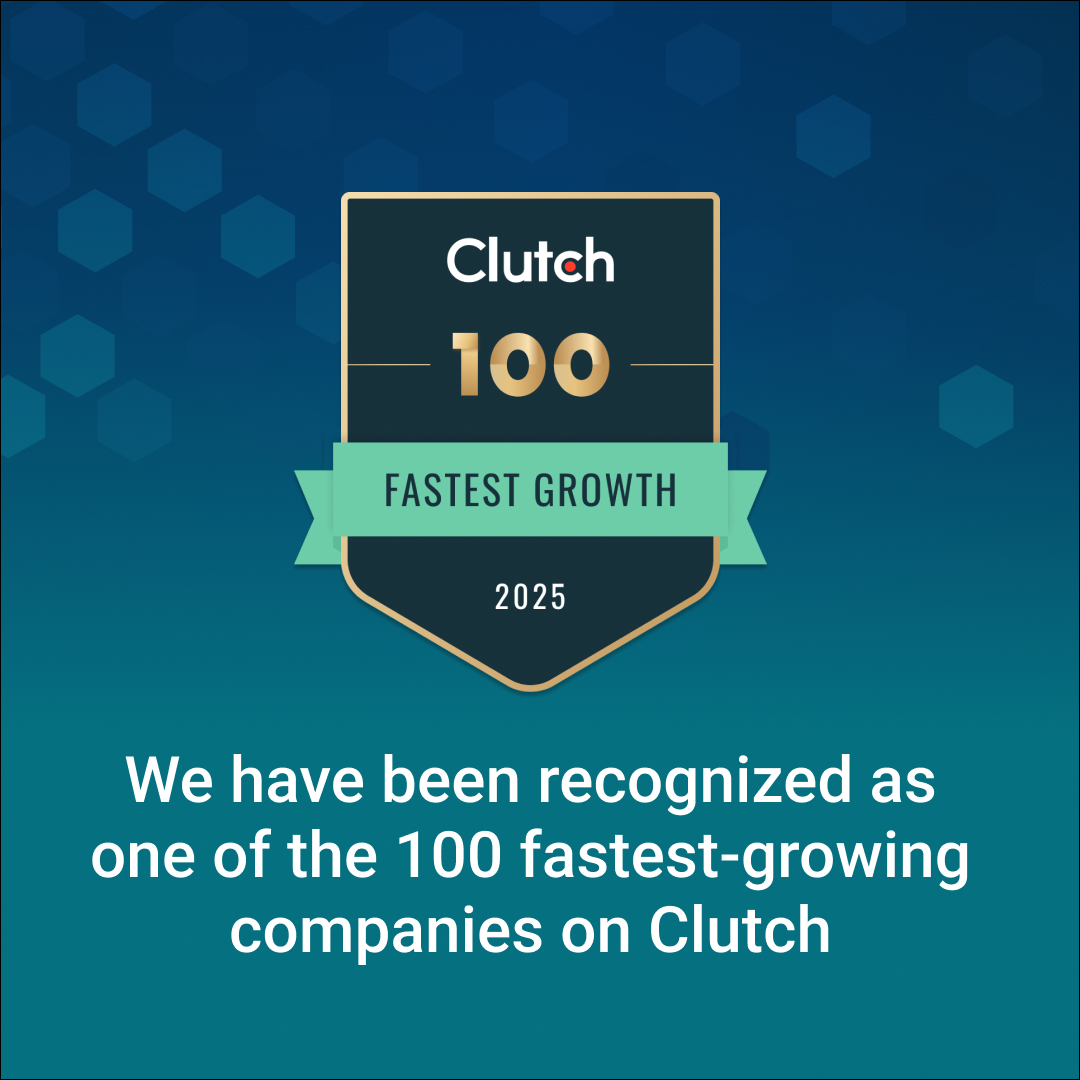Introduction
Public sector organizations are under increasing pressure to deliver efficient, responsive services while managing complex and diverse challenges. Artificial Intelligence (AI) is playing a pivotal role in reshaping how government services are provided, from improving citizen engagement to enhancing public safety and disaster response. This guide highlights the key AI use cases in the public sector, showcasing their potential to drive operational efficiency, innovation, and better outcomes for citizens.
What is AI and Why Does It Matter in Public Sector?

Definition of AI and Its Core Technologies
AI, or Artificial Intelligence, refers to machines simulating human intelligence to think, learn, and solve problems. Using core technologies like machine learning, natural language processing, and computer vision, AI enables systems to analyze data, recognize patterns, and make decisions autonomously, performing tasks that once required human intelligence.
In the public sector, AI’s potential to improve efficiency, enhance decision-making, and reduce costs is transformative. By automating routine tasks and providing deeper insights from data, AI can streamline operations, improve public services, and address complex societal challenges. The integration of AI into government operations helps drive smarter, data-driven policies and ensures better outcomes for citizens.
The Growing Role of AI in Transforming Public Sector
AI is transforming the public sector by automating tasks, enhancing decision-making, and improving service delivery. Governments are leveraging AI tools like predictive analytics and chatbots to streamline operations, reduce costs, and provide better services, making agencies more efficient and responsive.
By analyzing large datasets, AI enables data-driven decision-making, helping governments forecast trends and craft informed policies. This fosters more effective responses to challenges like healthcare, transportation, and climate change, allowing for proactive governance.
AI is also reshaping citizen interactions with public services. Virtual assistants and chatbots simplify processes, from applications to real-time support, and as AI evolves, it will offer more personalized, efficient solutions to meet citizens’ needs.
Key Statistics and Trends Highlighting AI Adoption in Public Sector
AI adoption in the public sector is growing rapidly, with the global AI in government market projected to reach $98.13 billion by 2033, growing at a CAGR of 17.8%. Governments are increasingly using AI to automate tasks, improve decision-making, and enhance citizen services.
In the U.S., 78% of public sector organizations are already using AI, with 90% planning to explore or implement agentic AI within the next few years. These advancements are driving increased efficiency in government operations and service delivery.
The regulatory landscape for AI is also expanding, with U.S. federal agencies introducing 59 AI-related regulations in 2024, more than double the previous year. This reflects growing attention to AI governance and the need for frameworks to ensure responsible deployment in public services.
Business Benefits of AI in Public Sector
AI offers significant benefits to the public sector, enhancing efficiency, reducing costs, and improving service delivery. By leveraging AI technologies, governments can streamline operations, make data-driven decisions, and deliver more personalized services to citizens.
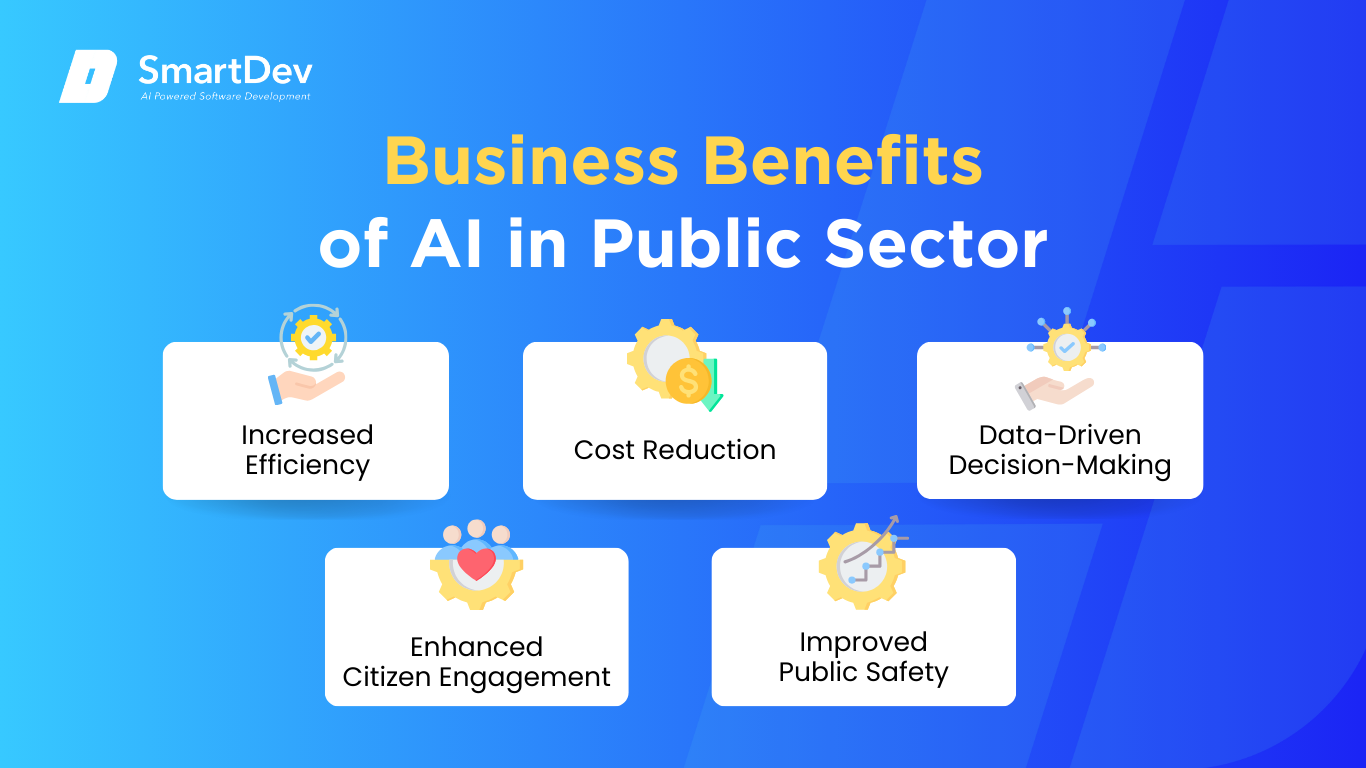
1. Increased Efficiency
AI enhances operational efficiency in the public sector by automating repetitive tasks, reducing human error, and speeding up service delivery. This allows agencies to streamline operations and allocate resources to more complex, high-impact activities.
By automating processes like data entry, document processing, and customer inquiries, AI boosts productivity across departments, enabling faster decision-making and better public service outcomes. The result is a more agile, responsive public sector that can manage demands more effectively.
2. Cost Reduction
AI helps public sector organizations cut costs by automating administrative tasks and optimizing resource allocation. This reduces the need for human intervention in low-value activities, leading to significant savings in labor costs, which can be redirected to essential services or infrastructure improvements.
AI-driven efficiencies also minimize operational waste, enabling governments to manage budgets more effectively. By using AI tools to assess and enhance processes, public agencies can optimize spending while maintaining service quality, resulting in sustainable cost management and better value from taxpayer funds.
3. Data-Driven Decision-Making
AI empowers the public sector to make more informed decisions by quickly and accurately analyzing large datasets. Predictive analytics identify trends and forecast outcomes, enabling governments to implement policies based on real-time insights, fostering strategic, proactive decision-making.
AI’s ability to process complex datasets also helps mitigate biases that may arise in human decision-making. By relying on objective data, public sector leaders can make fairer and more transparent decisions. This enhances the credibility of government actions and ensures that policies are tailored to meet the actual needs of the population.
4. Enhanced Citizen Engagement
AI enhances citizen engagement by offering accessible and responsive public services. Tools like chatbots and virtual assistants are available 24/7, reducing wait times and improving satisfaction by quickly addressing questions and service requests.
Additionally, AI personalizes services by analyzing citizen data and preferences, enabling governments to provide tailored solutions in areas like social services, healthcare, and education. This fosters stronger relationships and trust between the public and government agencies by meeting citizens’ unique needs.
5. Improved Public Safety
AI enhances public safety by enabling predictive policing and real-time monitoring of public spaces. By analyzing data, AI identifies crime patterns and allocates resources to high-risk areas, helping prevent incidents before they occur and allowing for more effective responses to emerging threats.
AI technologies, such as facial recognition and surveillance systems, further improve security by quickly identifying potential threats. These tools help law enforcement respond rapidly in high-stakes situations, ensuring safer communities and more efficient crisis management.
Challenges Facing AI Adoption in Public Sector
While AI presents numerous opportunities, its adoption in the public sector also comes with several challenges. Issues such as data privacy, integration with legacy systems, bias in algorithms, skills shortages, and the need for regulatory frameworks must be addressed to ensure the successful implementation of AI.
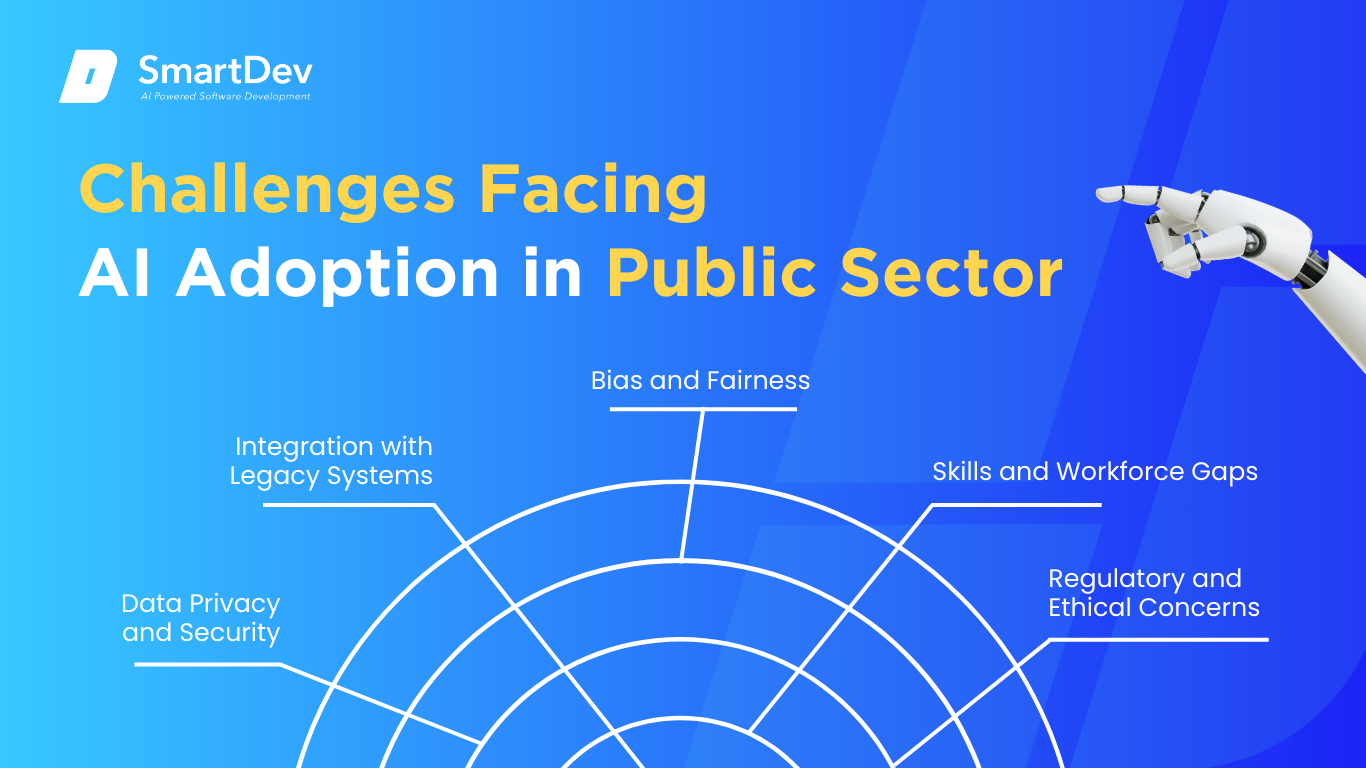
1. Data Privacy and Security
AI adoption in the public sector raises significant data privacy concerns, particularly when handling sensitive citizen information. Ensuring AI systems comply with privacy regulations and protect against unauthorized access is a major challenge, requiring robust cybersecurity measures.
As AI processes larger datasets, the risk of data breaches grows, making data protection even more critical. Governments must implement safeguards such as encryption and access controls to mitigate risks, balancing data usage with privacy protection in AI deployment.
To explore more on how AI is transforming cybersecurity, including its role in detecting anomalies and improving system resilience, check out our detailed guide on AI use cases in cybersecurity.
2. Integration with Legacy Systems
Many public sector organizations rely on outdated legacy systems, making AI integration complex. These systems often lack compatibility with modern technologies, requiring costly upgrades or re-engineering, and a phased approach is needed to minimize disruptions.
AI integration also demands significant staff training and changes to organizational processes, which can be resource-intensive. Budget constraints may further complicate the transition, making careful planning and investment essential for successful AI adoption.
For teams working directly with AI systems, our AI Model Testing Guide offers deeper insight into how to validate, monitor, and maintain machine learning models throughout their lifecycle.
3. Bias and Fairness
AI systems can perpetuate biases if not properly designed or trained, leading to unfair outcomes. Skewed data can result in AI algorithms that disproportionately affect certain groups, making fairness a key concern.
Governments must invest in transparent AI models and regularly test them for fairness to prevent reinforcing existing inequalities, particularly in areas like healthcare and law enforcement. Addressing bias is crucial to ensure equitable AI deployment in the public sector.
4. Skills and Workforce Gaps
The adoption of AI in the public sector is hindered by a shortage of skilled professionals in AI and data science. Governments face difficulties in finding and retaining the talent needed to effectively implement and manage AI technologies, making workforce development crucial for successful adoption.
Additionally, existing employees may require extensive training to work with new AI systems, which can be costly and time-consuming. Bridging the skills gap is a significant challenge for governments aiming to modernize operations and fully leverage AI’s potential.
5. Regulatory and Ethical Concerns
Governments face challenges in establishing clear regulatory frameworks for AI use in public services. Many countries are still developing guidelines to ensure ethical AI deployment, particularly in sensitive areas like surveillance and law enforcement, where proper regulation is essential to prevent misuse and maintain public trust.
Ethical concerns, such as transparency and accountability in AI decision-making, also need to be addressed. Citizens must understand how AI systems make decisions and hold governments accountable for their actions. Establishing comprehensive ethical guidelines for AI is critical for its responsible implementation.
Explore how ethical and explainability concerns are addressed in real-world deployments in our detailed guide on AI ethics concerns.
Specific Applications of AI in Public Sector

1. AI-Powered Predictive Policing
AI-driven predictive policing aims to anticipate where crimes are likely to occur, allowing law enforcement to deploy resources more effectively. By using historical crime data, weather conditions, and socio-economic factors, AI algorithms identify patterns that can predict future criminal activities. This proactive approach enables authorities to take preventive action rather than simply responding to crimes after they occur.
Predictive policing systems are primarily based on machine learning algorithms that analyze large datasets, such as crime reports, traffic patterns, and arrest histories. These algorithms identify trends and suggest areas where police forces should increase their presence. The data used for this purpose must be comprehensive and updated regularly to ensure the predictions are accurate and actionable.
While the technology brings efficiency, it also raises concerns around fairness and bias. If not properly managed, predictive policing systems can disproportionately target certain communities, perpetuating biases present in historical data. As a result, ethical considerations are crucial, with oversight and transparency needed to ensure AI tools are used responsibly.
Real-World Example:
The Los Angeles Police Department (LAPD) adopted PredPol, a predictive policing software that uses machine learning to predict crime hotspots. By analyzing historical crime data, PredPol has helped LAPD officers allocate resources more effectively, resulting in a reduction in crime rates. According to a study by the LAPD, PredPol contributed to a 15% reduction in property crime in some areas, although concerns over algorithmic bias persist.
2. Public Health Diagnostics and Resource Allocation
AI in public health leverages machine learning algorithms to analyze medical data, enhancing the accuracy of disease diagnoses and improving resource allocation. By processing large volumes of patient data, AI tools can detect patterns and identify potential health issues that might go unnoticed by human doctors. These applications are particularly valuable in public health, where the demand for fast and accurate diagnoses is critical.
AI also plays a crucial role in predicting disease outbreaks by analyzing patterns in health data, environmental factors, and population mobility. These predictive models help public health agencies prepare in advance, allocating medical resources to areas most at risk. AI-powered systems can also optimize hospital bed management, ensuring that resources are directed where they are needed the most.
However, implementing AI in healthcare requires addressing challenges such as ensuring data privacy and the integration of AI with existing medical systems. Additionally, healthcare providers must trust AI tools to make accurate recommendations, which requires rigorous validation and continuous monitoring. The potential for AI to enhance public health outcomes is significant, particularly when coupled with human expertise.
Real-World Example:
The National Health Service (NHS) in the UK has deployed IBM Watson Health to assist doctors in diagnosing various types of cancer, including breast and lung cancer. Watson analyzes medical records, lab results, and imaging data to recommend personalized treatment plans. According to a study by IBM, Watson’s recommendations aligned with expert oncologists’ treatment plans in 93% of cases, improving diagnostic accuracy and patient outcomes.
3. Smart City Infrastructure Management
AI in smart city management involves using AI algorithms to optimize city infrastructure, including traffic flow, energy use, and waste management. By analyzing real-time data from sensors and cameras, AI systems can make real-time decisions that improve the functioning of urban environments. These applications help cities become more sustainable, efficient, and livable.
In smart traffic management, AI can control traffic lights, predict congestion, and suggest alternative routes to reduce delays. AI can also optimize energy usage by analyzing data from buildings, streetlights, and other infrastructures, minimizing wastage. Furthermore, in waste management, AI-powered systems can predict when bins will be full, helping municipalities plan waste collection routes efficiently.
While these solutions promise improvements in efficiency and sustainability, they also raise concerns regarding data privacy and surveillance. As AI systems collect data from public spaces, it is crucial to ensure that citizens’ privacy is protected and that data is used responsibly. Additionally, significant investment is needed to integrate these systems into existing urban infrastructures.
Real-World Example:
Singapore has implemented AI-driven systems for smart traffic management through Green Wave. The system analyzes data from traffic sensors, cameras, and vehicles to optimize traffic light timings and reduce congestion. Since its deployment, Singapore has seen a 15-20% reduction in travel time and a notable decrease in carbon emissions, contributing to its Smart Nation initiative.
4. Public Sector Document Automation and Workflow Optimization
AI applications in document automation enable public sector organizations to reduce administrative burdens by automating repetitive tasks like document review and data entry. Machine learning algorithms can process large amounts of unstructured data, categorizing and organizing it efficiently. This significantly speeds up government processes such as permits, licenses, and tax filings, improving service delivery.
AI-based systems such as natural language processing (NLP) can analyze written documents to extract key information, making it easier for government employees to manage large volumes of data. These systems can also help with form recognition and data validation, reducing errors and ensuring compliance with regulations. By automating routine tasks, AI frees up public sector employees to focus on more complex and strategic functions.
Despite the advantages, integrating AI into existing public sector workflows can be challenging due to regulatory complexities and bureaucratic structures. AI systems must be designed to comply with legal frameworks and ensure data privacy. However, when properly implemented, AI-powered document automation can lead to significant cost savings and enhanced productivity.
Real-World Example:
US Citizenship and Immigration Services (USCIS) uses AI for automating document processing and case management. By employing machine learning and natural language processing (NLP), USCIS can quickly review and categorize immigration applications, speeding up the processing time. This AI integration has reduced the processing time by up to 30%, improving efficiency in the handling of cases.
5. Public Sector Fraud Detection and Risk Management
AI is increasingly being used in the public sector to detect and prevent fraud in areas like taxation, procurement, and social services. Machine learning models can quickly analyze massive datasets to spot irregularities and prevent fraud before it happens. By detecting fraud in real-time, AI helps mitigate financial risks and safeguard public funds.
AI-based fraud detection systems analyze large datasets, looking for patterns or outliers that deviate from established norms. In addition to identifying fraud, AI can also help optimize risk management strategies by predicting areas where fraud is likely to occur. These systems enable public agencies to proactively address potential issues, reducing financial losses and improving governance.
However, implementing AI for fraud detection requires continuous monitoring to ensure that the models remain effective as fraud tactics evolve. Public agencies must also address concerns about data privacy and ensure that AI systems are used transparently and ethically. Despite these challenges, AI is a powerful tool for enhancing the security and integrity of public sector finances.
Real-World Example:
The Internal Revenue Service (IRS) uses AI to detect fraudulent tax returns and prevent tax evasion. Through machine learning algorithms, the IRS analyzes millions of tax filings to flag suspicious claims. As a result, the IRS has recovered billions of dollars in unpaid taxes, significantly reducing fraudulent tax filings.
6. Public Sector Talent Acquisition and HR Management
AI helps public sector organizations improve the efficiency of their recruitment processes by automating tasks like resume screening, candidate assessment, and interview scheduling. AI-based systems can analyze resumes and applications to determine candidate suitability, improving the efficiency of the hiring process. This is particularly valuable in large-scale recruitment efforts where manually reviewing thousands of applications would be time-consuming and inefficient.
AI-powered systems assess candidates based on various criteria, such as qualifications, experience, and even personality traits, ensuring a fairer and more objective evaluation process. By using AI to automate initial screenings and interviews, public sector organizations can reduce bias in recruitment and make faster, data-driven hiring decisions. These technologies also help in identifying skill gaps and future talent needs within the workforce.
However, AI in recruitment must be carefully monitored to ensure fairness and transparency. Algorithms must be regularly tested for bias and adjusted to ensure they align with diversity and inclusion goals. If implemented correctly, AI can significantly improve talent acquisition efforts, leading to a more efficient and equitable hiring process.
Real-World Example:
The UK Civil Service uses AI-powered tools like HireVue to streamline recruitment. This AI system analyzes video interviews, assesses candidates’ responses, and helps hiring managers make more objective decisions. The use of AI has led to faster recruitment processes and a more diverse talent pool, with the Civil Service reporting a 50% reduction in the time it takes to fill vacancies.
Need Expert Help Turning Ideas Into Scalable Products?
Partner with SmartDev to accelerate your software development journey — from MVPs to enterprise systems.
Book a free consultation with our tech experts today.
Let’s Build TogetherExamples of AI in Public Sector
As AI continues to transform the public sector, its real-world applications showcase its potential to improve efficiency, safety, and service delivery. The following case studies highlight how AI is being successfully implemented across various government functions to drive impactful change.
Real-World Case Studies
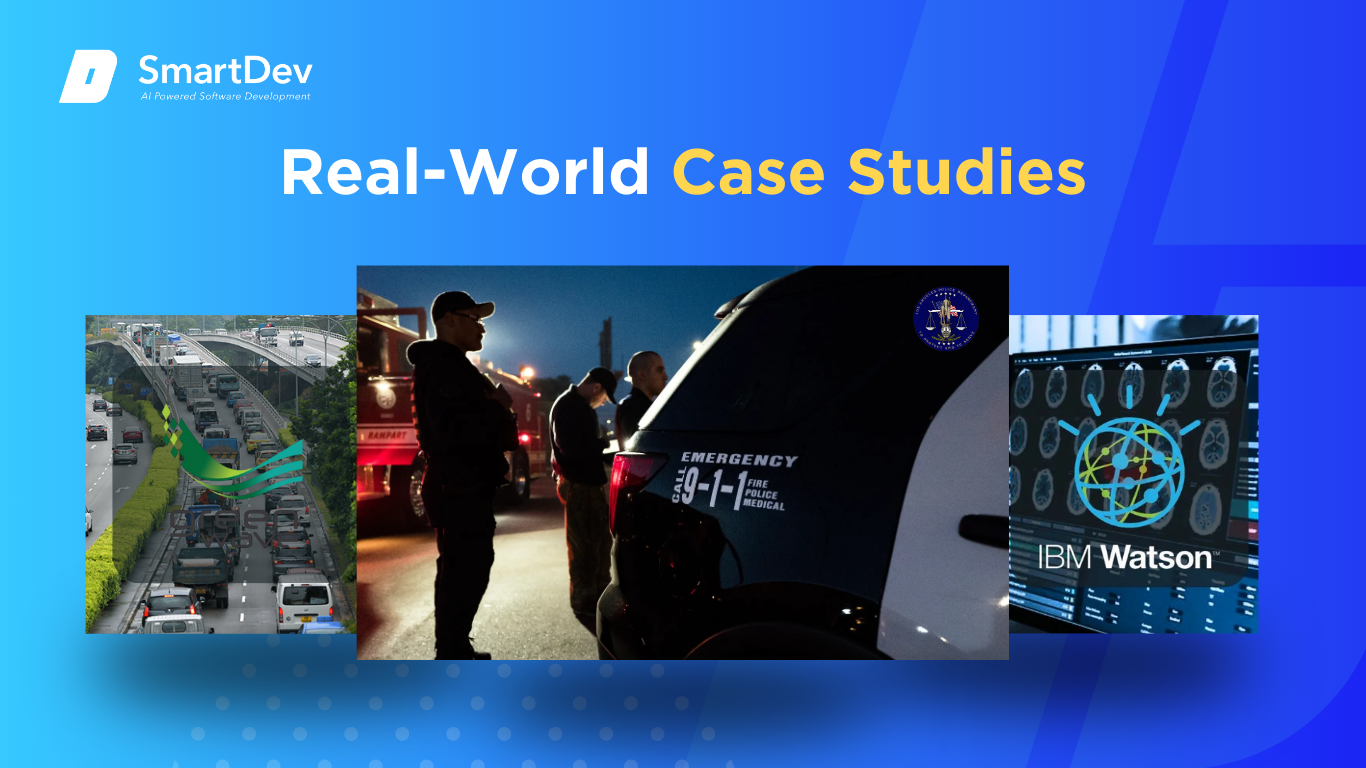
1. Los Angeles Police Department: Predictive Policing with PredPol
The Los Angeles Police Department (LAPD) uses PredPol, an AI tool, to predict crime hotspots based on historical crime data. This allows officers to allocate resources more effectively and proactively prevent crime. PredPol has helped reduce property crimes by 15% in some areas, though concerns over algorithmic bias persist, particularly regarding its impact on minority communities.
While effective in resource allocation, PredPol has faced criticism for potentially reinforcing existing biases, as it may disproportionately target certain neighborhoods. The LAPD continues to work on refining the tool to ensure fairness and transparency in its use.
2. NHS: AI-Powered Cancer Diagnosis with IBM Watson
The NHS in the UK uses IBM Watson for Oncology to assist in diagnosing and recommending cancer treatments. Watson analyzes medical data to provide evidence-based treatment suggestions, improving diagnosis speed and accuracy. The system has aligned with expert oncologists in 93% of cases, leading to better treatment outcomes.
Watson’s ability to process vast datasets has proven invaluable in oncology, where fast, accurate decisions are critical. The tool’s use has resulted in more personalized and precise cancer care, benefiting both clinicians and patients.
3. Singapore: AI-Powered Smart Traffic Management
Singapore’s Green Wave system uses AI to optimize traffic light timings based on real-time traffic data. This system reduces congestion, improves road safety, and supports the city’s sustainability goals. As a result, it has decreased travel times by 20% and helped reduce carbon emissions.
The Green Wave system adjusts traffic signals dynamically, minimizing delays and fuel consumption. It is a model for other smart cities aiming to enhance urban mobility and environmental sustainability.
Innovative AI Solutions
Emerging AI technologies are being adopted to tackle new challenges in the public sector. For instance, the EPA in the United States uses AI to monitor air quality and guide policy decisions based on real-time data. These AI systems help cities address pollution more effectively and create data-driven environmental regulations.
AI is also enhancing infrastructure management, with General Electric (GE) using predictive maintenance to optimize public transportation systems and city infrastructure. By analyzing data from sensors, AI predicts when repairs are needed, reducing costs and improving reliability. This approach allows municipalities to better manage resources and minimize downtime.
Explore how AI streamlines workflows and drives performance improvements in our guide to unlocking operational efficiency with AI.
AI-Driven Innovations Transforming Public Sector
Emerging Technologies in AI for Public Sector
Emerging AI technologies are transforming the public sector by enhancing efficiency and service delivery. Generative AI is automating tasks like document drafting and summarizing meetings, allowing public servants to focus on more complex duties. Additionally, AI systems are handling scheduling and citizen inquiries, further streamlining operations.
Governments are focusing on responsible AI deployment by creating frameworks that promote transparency and accountability. This includes involving citizens in AI development to ensure alignment with public values and legal standards. These efforts are vital for fostering trust and ensuring ethical AI integration in public services.
AI’s Role in Sustainability Efforts
AI is crucial in advancing sustainability by optimizing resource use and minimizing environmental impact. In energy, it enhances grid management, forecasts demand, and supports the integration of renewable sources like wind and solar power. In agriculture, it helps optimize irrigation, reducing water waste and promoting more sustainable farming practices.
The technology also plays a key role in monitoring environmental changes and predicting future trends. Machine learning models analyze climate data to forecast extreme weather events, allowing governments and organizations to better prepare for disasters. Additionally, it improves waste management by identifying patterns in recycling and streamlining collection systems, contributing to a circular economy.
How to Implement AI in Public Sector
Implementing AI in the public sector involves a thoughtful, step-by-step approach to ensure that technology aligns with organizational goals and public needs. It requires careful consideration of resources, data infrastructure, and stakeholder engagement to achieve meaningful, long-term impact.
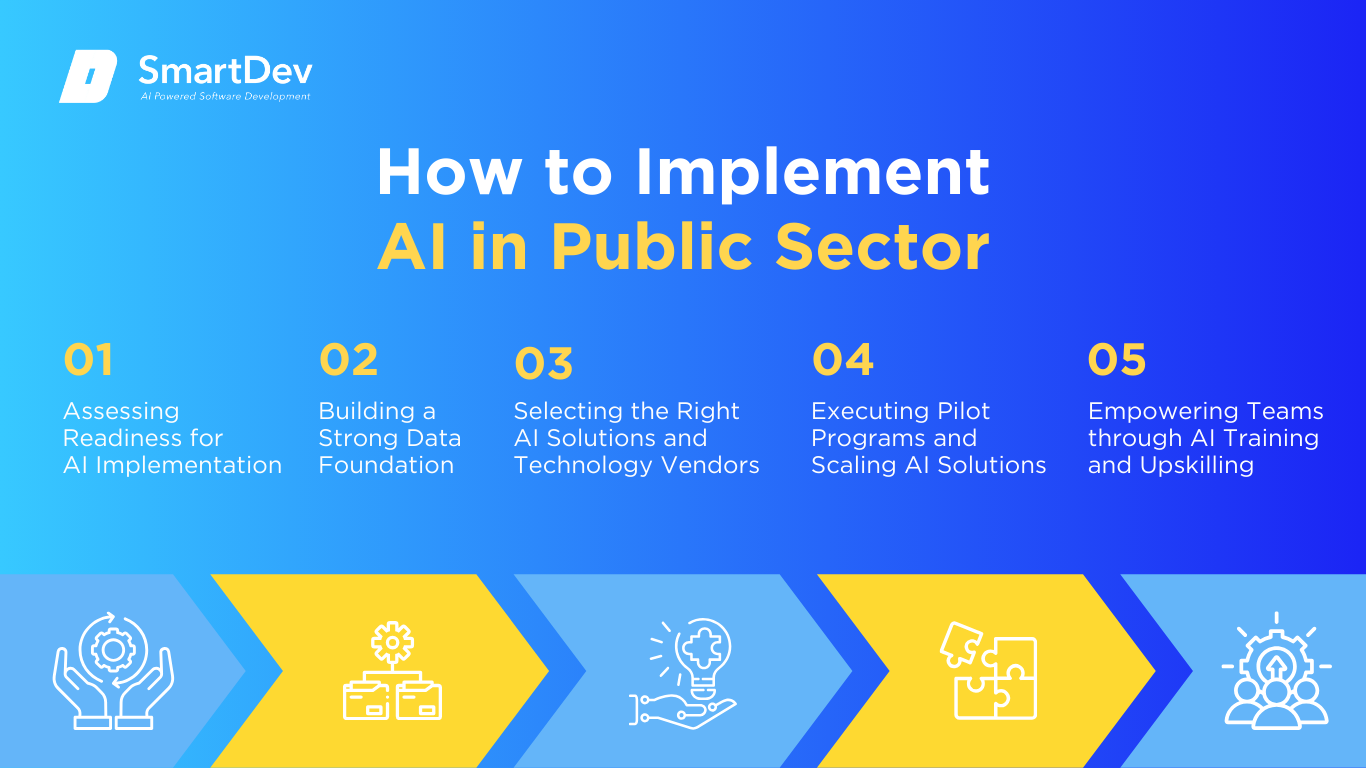
Step 1: Assessing Readiness for AI Adoption
Before adopting AI, it’s crucial to assess your organization’s readiness. Begin by identifying key processes that could benefit from automation, such as data management or routine service tasks, which often provide immediate value by streamlining operations and reducing inefficiencies.
In addition, evaluate your organization’s culture and leadership commitment. AI adoption requires a mindset shift, so having leadership buy-in and a clear vision is vital for success. Resistance or a lack of understanding can hinder implementation, so ensuring decision-makers support the transformation is essential.
Explore our data analytics services to see how we help businesses implement AI solutions that scale.
Step 2: Building a Strong Data Foundation
AI systems rely on clean, organized data to function effectively, so building a strong data infrastructure is essential. Start by organizing data into a centralized, accessible system to ensure accuracy and consistency, enabling AI to process information efficiently and generate actionable insights.
Data governance is also critical to maintain integrity and comply with privacy standards. Well-maintained datasets enhance the reliability of AI models, ensuring trustworthy insights. A solid data infrastructure lays the foundation for scalable AI solutions and long-term success.
Explore why clean, well-governed data is the foundation of successful AI adoption in our data management guide.
Step 3: Choosing the Right Tools and Vendors
Choosing the right AI tools involves aligning technology with your organization’s needs and goals. Select solutions that address your specific challenges and integrate seamlessly with existing systems, ensuring maximum value from AI.
When evaluating vendors, ensure transparency about how their solutions work and handle data. Understanding the long-term support and updates available is crucial, as the AI landscape evolves rapidly. The right vendor will ensure your AI tools can scale with your needs and maintain security throughout their lifecycle.
Step 4: Pilot Testing and Scaling Up
Starting with pilot projects lets you test AI solutions in low-risk areas and assess their effectiveness. These small-scale trials help identify challenges, measure success, and refine your approach without disrupting larger operations, building confidence before full implementation.
Once initial tests show positive results, scale AI efforts across the organization. Leverage insights from the pilot phase to refine workflows, integrate AI into more departments, and maximize impact. Continuous iteration ensures that AI adoption remains practical and aligned with organizational goals.
Step 5: Training Teams for Successful Implementation
To ensure successful AI integration, invest in training teams to effectively use AI tools. Provide hands-on learning experiences that help employees understand how AI enhances their roles, easing the transition and promoting tool adoption.
Encourage collaboration between technical and operational teams to create a holistic approach to AI. By empowering employees to understand both technical and practical aspects of AI, the technology will complement their expertise, improving workflows. A well-prepared workforce is essential for long-term AI success.
To ensure successful AI integration, institutions should start with a clear roadmap. Our guide for tech leads outlines how to assess readiness and align stakeholders from the start.
Measuring the ROI of AI in Public Sector
Key Metrics to Track Success
To measure AI’s ROI in the public sector, it’s important to focus on both efficiency and impact. Key metrics such as improved productivity, like reducing processing times or automating routine tasks, demonstrate how AI frees up resources for more strategic work. Cost savings also play a significant role, with AI reducing the need for manual labor and improving resource allocation.
In addition to tangible savings, tracking indirect benefits is equally important. Metrics like faster response times, better citizen engagement, and more informed decision-making show the broader value of AI in improving services. By considering both measurable and qualitative outcomes, public sector organizations can capture the full impact of AI on their operations.
Case Studies Demonstrating ROI
AI adoption in the public sector has shown impressive ROI through real-world examples. In Brisbane, the implementation of AI-powered traffic systems resulted in a 20% reduction in travel time, demonstrating how AI can optimize urban mobility and reduce congestion. Similarly, in Singapore, AI chatbots have enhanced citizen services by improving response times, allowing government departments to serve citizens more efficiently.
Other case studies show significant cost savings and operational improvements. For example, Chennai’s AI-driven adaptive traffic signals have reduced wait times at 165 junctions, contributing to smoother traffic flow. Additionally, the Telangana State Cyber Security Bureau’s AI chatbot reduced call wait times from 5 minutes to 2 minutes, improving emergency response efficiency.
Common Pitfalls and How to Avoid Them
A common mistake in measuring AI ROI is focusing only on cost savings or speed improvements, while overlooking broader impacts like enhanced service quality and citizen satisfaction. To truly assess AI’s value, both financial and qualitative benefits should be considered.
Another challenge is the lack of baseline data, making it difficult to track progress. Without clear starting points, it’s hard to determine AI’s true impact. To avoid this, establish benchmarks before implementation and regularly monitor performance to ensure the technology delivers expected results.
Learn how to evaluate AI model effectiveness and ROI with our practical guide on AI performance metrics.
Future Trends of AI in Public Sector
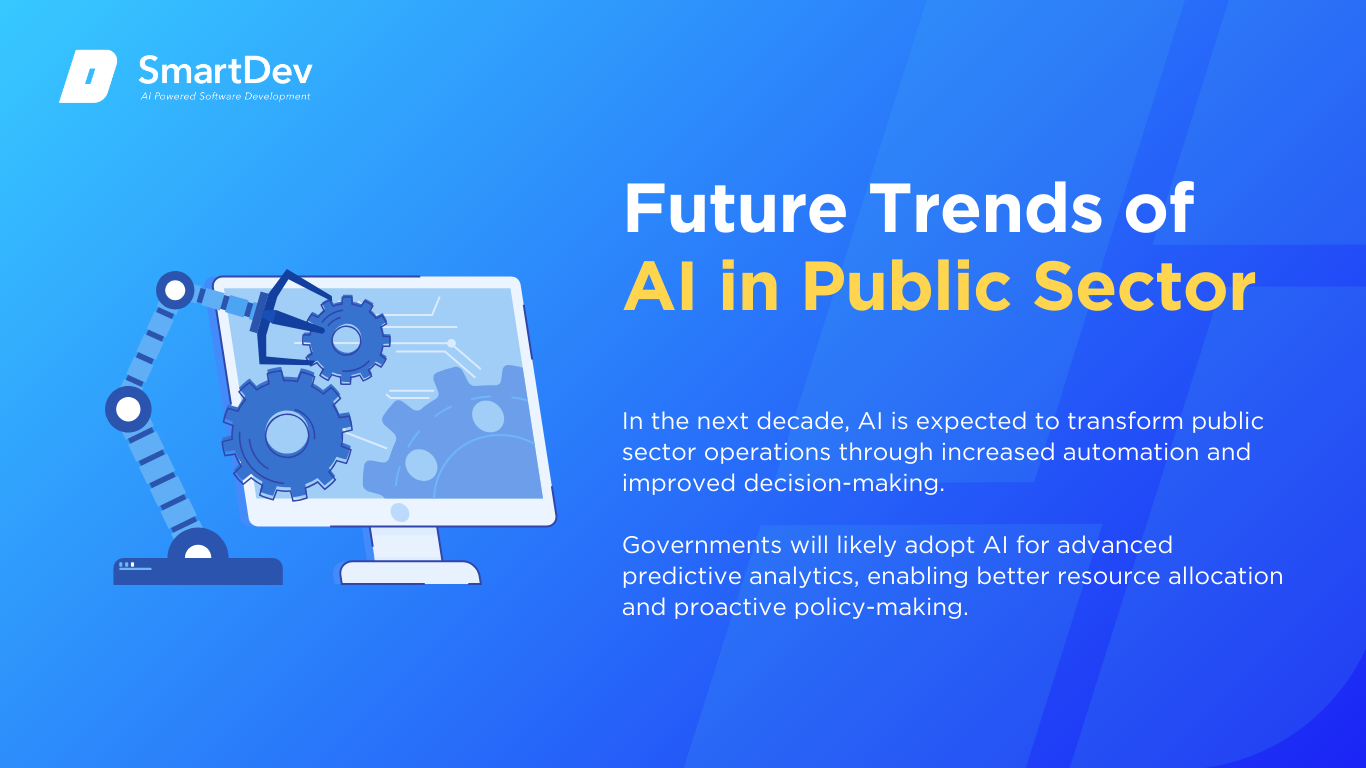
Predictions for the Next Decade
In the next decade, AI is expected to transform public sector operations through increased automation and improved decision-making. Governments will likely adopt AI for advanced predictive analytics, enabling better resource allocation and proactive policy-making. AI-driven tools will also enhance public safety with smarter surveillance systems and more efficient emergency responses, revolutionizing city management.
AI will play a central role in citizen engagement, offering more personalized and efficient public services. Chatbots and virtual assistants will become ubiquitous in government interactions, providing 24/7 support and streamlining administrative tasks. As AI evolves, we can expect significant improvements in transparency, accountability, and efficiency, fundamentally reshaping how governments serve their citizens.
How Businesses Can Stay Ahead of the Curve
To stay ahead of the curve, businesses must embrace innovation and adapt to market changes. Investing in emerging technologies like AI, automation, and data analytics enhances operational efficiency, improves customer experiences, and enables data-driven decisions. Staying agile ensures businesses can quickly pivot and maintain a competitive edge.
Fostering a culture of continuous learning and collaboration is also crucial. Encouraging employees to develop new skills and stay updated on industry trends helps the organization remain forward-thinking. By monitoring competitors and market shifts, businesses can anticipate challenges and seize new opportunities before they become mainstream.
To see which emerging technologies are shaping AI adoption in the next decade, our IT landscape trends recap and guide for business to intergrating AI in 2025 breaks down the must-watch shifts for business leaders.
Conclusion
Key Takeaways
AI is transforming the public sector by enhancing efficiency, service delivery, and decision-making in areas like smart cities, healthcare, and citizen services. It helps governments optimize resources, improve safety, and provide better experiences through predictive analytics and automation.
Successful AI implementation requires careful planning, including assessing readiness, building strong data foundations, and selecting the right tools. As AI evolves, its role in the public sector will grow, leading to more efficient, transparent, and responsive systems in the future.
Moving Forward: A Strategic Approach to AI-Driven Transformation
As AI continues to reshape public sector operations, now is the time to assess how this transformative technology can optimize your services and improve efficiency. From enhancing citizen engagement to streamlining decision-making and resource management, AI is essential for staying ahead in an increasingly digital world.
At SmartDev, we specialize in helping government agencies harness the power of AI to drive innovation and improve public service delivery. Whether you’re looking to automate processes, improve data analysis, or enhance public safety, our team offers tailored AI solutions to meet your specific needs.
Explore our AI-powered software development services to see how we develop custom systems for data integration, predictive analytics, and real-time decision-making.
Contact us today to learn how AI can help you stay ahead of the curve and deliver better outcomes for your community.
—
References:
- AI In Government And Public Services Market Summary | Grand View Research
- Public Sector Leaders Must Act Now to Capture AI Opportunities | MGT.AI
- The 2025 AI Index Report | Stanford HAI
- AI adoption in public administration: Perspectives of public sector managers and public sector non-managerial employees | ScienceDirect
- Nine in ten public sector organizations to focus on agentic AI in the next 2-3 years, but data readiness is still a challenge | CapgeminiCapgemini
- LAPD ended predictive policing programs amid public outcry. A new effort shares many of their flaws | The Guardian
- Smarter hospitals: UK Hospitals are moving to hospital 2.0 | IBM
- The Role Of AI In USCIS: Key Facts And Implications | Forbes
- How AI is Transforming Air Quality Monitoring | AICompetence.org
- Emerging Practices in Participatory AI Design in Public Sector Innovation | arXiv


